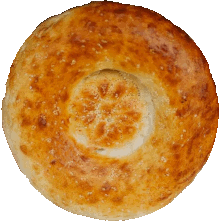What is Obi non
Obi non is a very important word for millions of people living in Central Asia. The day begins with Obi non and it ends with it. Obi non is something that can be found in practically everywhere. Obi non - that is what appeared here since the birth of the first settled civilization, has existed for thousands of years and will undoubtedly exist as long as people will live here. Obi non - that reminds the sun, generously giving warmth and light to those living under it. Obi non is what people take with them when they are going on a long journey and what they want to see when they return home. Obi non - that is what people who have left this homeland cannot forget. Obi non - is flatbread made in a traditional way in a tandoor - a clay oven fired with coal. Every day, hundreds of millions of flatbreads are prepared throughout the region to feed people and for truly bread is the main dish of the table. You can see it in regular life and and it also plays important role in special life events such wedding or birthday. And, in the end, without it, all other dishes will not be as tasty as they are with it.
The Recipe
The Recipe is fairly easy - as nearly all daily breads it is made from wheat flour, water and with or without yeast. Sometimes the milk and vegetable oil can be added. Someone use to say that the local water is what makes the Obi non so special, some people claim that there is special and unique yeast, some are saying that the traditional clay oven is the secret ingredient. That's hard to define how many of these claims are true. But what is absolutely doubtful - it is hard to find the originally tasting Obi non outside the region.

The Region
Central Asia is the ancient cradle of many civilizations that originated here, reached greatness and disappeared in the dust of centuries. The culture of the region is diverse and unique. People are kind and sympathetic - the ancient laws of hospitality are what old people teach their children and what they will teach their children when the time comes and that will continue until the end of time.
 There was a time when the region was part of states competing in size and greatness with the ancient Roman Empire - there are still many architectural monuments of those times on the territory of the region, amazing in their beauty and originality.
There was a time when the region was part of states competing in size and greatness with the ancient Roman Empire - there are still many architectural monuments of those times on the territory of the region, amazing in their beauty and originality.

The Country
Nowadays, there are several countries in the region, among which Uzbekistan occupies a central position - the pearl of the region, famous for its ancient cities, high snowy mountains, green valleys, hot deserts, endless plains and the infinitely kind and generous people living there.
 Uzbekistan is a modern dynamic country, an attractive tourist destination, famous for its natural and historical monuments, smiling people and unique cuisine, which is hard to find equal. And, of course, fresh, hot, bread - Obi non.
Uzbekistan is a modern dynamic country, an attractive tourist destination, famous for its natural and historical monuments, smiling people and unique cuisine, which is hard to find equal. And, of course, fresh, hot, bread - Obi non.
The Cities
The capital city of Uzbekistan is Tashkent ("Stone City"). That's where your journey begins. The ancient city with 2000+ years history and yet modern and progressive capital which has marks of all epochs which were touching it during its long history. From the ancient ruins of Ming Uriq ("Thousand Apricots") city tracing back to Zoroastrian past to the "old", traditional city build during Arabic expansion over the region, to the Russian Empire time when the region was joined to Russia Empire, then to USSR time when city was destroyed and then rebuild after terrible earthquake with help of architects and builds of other USSR republics and finally by the modern era when the Uzbekistan acquired it independence. There are many other cities in Uzbekistan which are worth of mentioning but two of them are standing aside. The first is Smaraqand - the ancient capitol of Aphrosiab and later the capita of Amir Temur empire. That city is true gem, full of historical evidences of Temurides empire greatness - the ancient mosks, minarets, observatory - literally each historical building or place has the story behind of it, story worth telling and remember. The another city is Bukhara - the ancient centre of Sufism (mystical branch of Islam religion). This city preserved the ancient environment similarly to Samarqand and famous across the Uzbekistan for its unique and delicious cousin.

The People
There are many different nations and ethnic groups live in the region - Uzbeks, Tajiks, Kazakhs, Russians, Kirgises, Tartars, Turkmens, Koreans, Ukrainians and many others. Travelling trough the region you will experience the true fusion of these cultures. On the streets of Tashkent you can meet the Russian speaking Korean preparing for you a traditional Uzbek food. Don't be surprised - the Central Asia is still one of destinations of Great Silk Road which may be doesn't exist anymore but the people still keep the traditions of hospitality and tolerance.
